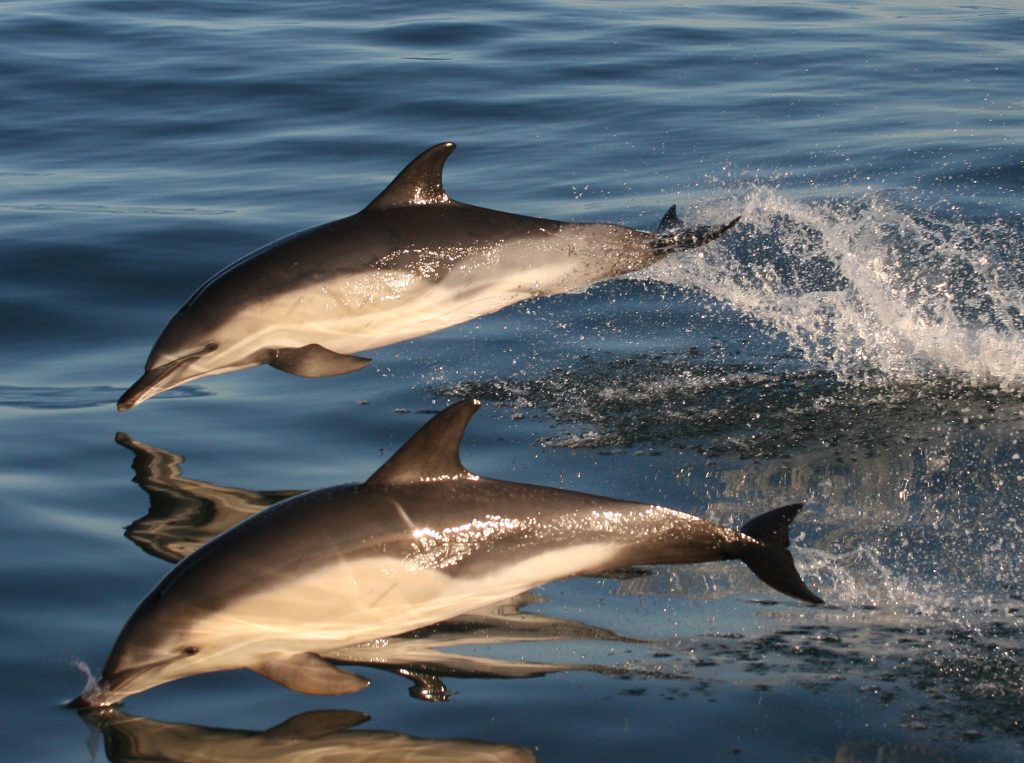Over time, cetaceans have become highly adapted to their surroundings and the challenges that the underwater environment can bring. As with many other animals, communication is essential in the social structure of different species and is specifically important in activities such as foraging, reproduction and avoiding predators, but also for expressing individual identity, status and mood (Laiolo, 2010). Within the dark and dense environment of the ocean, how do cetaceans rely on their acoustic senses for survival and how does anthropogenic activity have an impact?

How do cetaceans communicate?
Cetaceans communicate in a variety of verbal and non verbal ways via sound, body language and physical contact (NOAA, 2021; WDC, no date). Due to the challenging characteristics of the marine environment, cetaceans have adapted to having highly developed and unique sensory systems in order to survive underwater (Akamatsu, 2008), with acoustics being their primary and most important method of communication (Pavan and Borsani, 1997). While most of the sounds that cetaceans make are for communication purposes, they also play an important role in their navigation, which is particularly essential in activities such as foraging for food (Herzing, 2014).
The primary types of sounds that cetaceans make are whistles, clicks and burst-pulse sounds (NOAA, 2021; Herzing, 2014). Whistles and burst-pulse sounds are used primarily for social communication with other animals, both within and outside of their own species. Previous studies have found there to be differences in vocal dialects within each pod, so they can differentiate between themselves and other pods (NOAA, 2021), even having a signature whistle for each individual member (WDC, no date).
Clicks are sounds that are used more frequently for navigational purposes by using echolocation (NOAA 2021; WDC, no date). This enables the animal to identify objects and other creatures around them, by emitting soundwaves and detecting the echo it creates when they reflect off the object. This allows them to gather details about their surroundings in an environment with low visibility, such as the shape of an object or to determine whether the animal is friendly or a threat (NOAA 2021; WDC, no date).

Differences between species
While cetaceans generally all use whistles and clicks, small differences exist among different species. Baleen whales generally utilise these sounds for communication rather than for echolocation. One example is when male humpback whales are migrating to and from their breeding grounds, they produce and repeat specific songs (Noad et al., 2000). These larger whales are often solitary creatures, and are able to produce sounds that travel over significant distances by using low frequencies, with the sound sometimes travelling across entire ocean basins (NOAA, 2021). Another specific example is the sperm whale, which is able to make sounds up to 233db, making them the loudest animal on earth (WDC, no date).
Toothed whales such as dolphins and porpoises are more widely known to use higher frequencies, therefore sound travels at more limited distances (NOAA, 2021). Dolphins are highly social and more chatty animals and are easier to hear due to their level of frequency, whereas porpoises appear to verbally communicate less and at much higher frequencies which aren’t audible to the human ear (Cole, 2020).
The importance of sound
Despite cetaceans being equipped with good eyesight, the visibility level in water dramatically decreases with depth, therefore many underwater organisms have adapted to rely on sound and hearing for navigation (Spence, 2015). As light reflects off the surface of the ocean, it is absorbed at rapid rates as it travels down the water column, leaving little to no light as you reach approximately 200 metres deep (Spence, 2015). This will have had an impact on the increased development of other senses and thus creating a reliance on sound in their environment (Ashworth, 2022). As echolocation allows cetaceans the ability to build a picture of their surroundings, this is vitally important for success in hunting for food, avoiding predators, reproduction and general navigation in areas of such low visibility (Ashworth, 2022).
While cetaceans don’t have external ears due to their streamlined shape, they have excellent hearing sensitivity (Herzing, 2014) and are able to hear sounds via structures in their jawbones (WDC, no date). They utilise this advantage in both passive and active sonar activity (Herzing, 2014) whereby listening to their surroundings enables them to gain information and to avoid predators, similarly using that information for the final targeting of their own prey (Herzing, 2014).
The impacts of noise pollution
Exposure to anthropogenic noise pollution can significantly harm or even prove fatal to cetaceans, and this is unfortunately another form of pollution that’s growing on a global scale (Spence, 2015). Cetaceans rely on sound for echolocation and communication, and with the speed that sound travels underwater, they are impacted almost immediately after loud noises occur (Ashworth, 2022). Sound is able to travel as fast as 1500 metres per second in seawater, in comparison to the 340 metres per second in air (Spence, 2015), and is able to travel at these rapid speeds over vast distances due to the more tightly packed molecular structure that exists in water (Ashworth, 2022). While this factor can positively impact their ability to echolocate and communicate more effectively (Ashworth, 2022), it can also negatively impact them when exposed to noise pollution.
Noise pollution arises from both natural and anthropogenic causes. Common anthropogenic noise pollution involves vessels, deep sea mining, fossil fuel extraction and naval sonar activities (Ashworth, 2022; NOAA, 2022). As these loud noises travel at rapid speeds underwater, this causes immediate distress to the animals, causing behavioural change and encouraging them to dive or surface too quickly causing fatal decompression sickness (Ashworth, 2022). These factors can also impact biological activities due to increased energy expenditure and decreased time spent on activities such as foraging (Ashworth, 2022). These factors can both directly and indirectly link to stranding events which often result in singular or mass fatalities of the animals.

Noise pollution adds to the ongoing list of threats faced by cetaceans such as climate change, bycatch, plastic pollution and overfishing. Find out how you can help by visiting our website at www.seawatchfoundation.org.
Rachael Anderson Feature Blogger References Akamatsu, T. (2008) ‘Cetacean Bioacoustics with Emphasis on Recording and Monitoring’, Handbook of Signal Processing in Acoustics, pp. 1897-1907. Ashworth, J. (2022) ‘Underwater noise pollution is risking the lives of whales and dolphins’, Natural History Museum. Available at: https://www.nhm.ac.uk/discover/news/2022/july/underwater-noise-pollution-risking-lives-whales-dolphins.html (Last accessed: 15/11/2022). Cole, A. (2020) ‘What are the Differences between Whales, Dolphins and Porpoises?’. Available at: https://blog.cwf-fcf.org/index.php/en/what-is-the-difference-between-whales-dolphins-and-porpoises/ (Last accessed: 15/11/2022). Herzing, D.L. (2014) ‘Clicks, whistles and pulses: Passive and active signal use in dolphin communication’ Acta Astronautica, 105 (2), pp.534-537. How do dolphins communicate? (no date) Whale & Dolphin Conservation UK. Available at: https://uk.whales.org/whales-dolphins/how-do-dolphins-communicate/ (Last accessed 15/11/2022). Laiolo, P. (2010) ‘The emerging significance of bioacoustics in animal species conservation’, Biological Conservation, 143 (7), pp. 1635-1645. Noad, M.J., Cato, D.H., Bryden, M.M., Jenner, M.N., Curt, K. and Jenner, S. (2000) ‘Cultural revolution in whale songs’, Nature, 408 (537). Ocean Noise (2022) NOAA. Available at: https://www.fisheries.noaa.gov/national/science-data/ocean-noise (Last accessed: 15/11/2022). Pavan, G. and Borsani, J.F. (1997) ‘Bioacoustic research on cetaceans in the Mediterranean Sea’ , Marine and Freshwater Behaviour and Physiology, 30 (2), pp.99-123. Resources for Guides and Educators (no date) International Whaling Commission. Available at: https://wwhandbook.iwc.int/en/downloadable-resources/resources-for-guides-and-educators (Last accessed: 15/11/2022). Spence, H.R. (2015) ‘The importance of bioacoustics for dolphin welfare: Soundscape characterization with implications for management’. Available at: https://www.researchgate.net/publication/288826567_The_importance_of_bioacoustics_for_dolphin_welfare_Soundscape_characterization_with_implications_for_management (Last accessed: 15/02/2022). Why do whales make sounds? (2021) NOAA. Available at: https://oceanservice.noaa.gov/facts/whalesounds.html (Last accessed 15/11/2022).
























